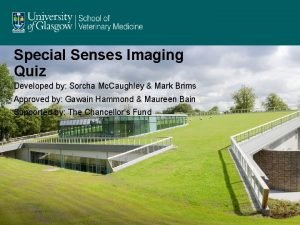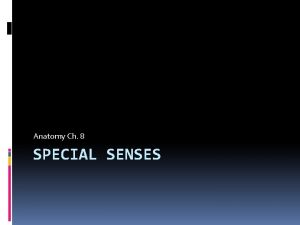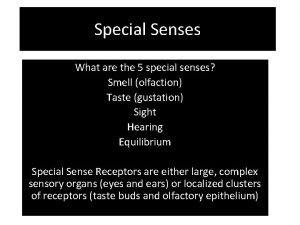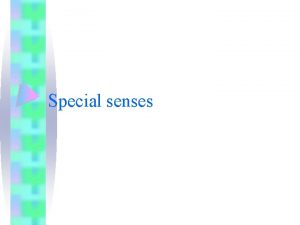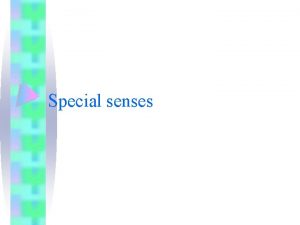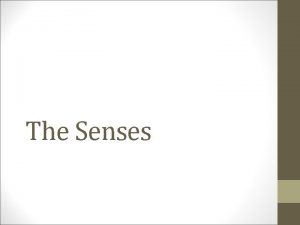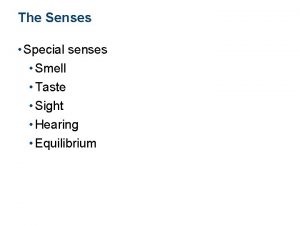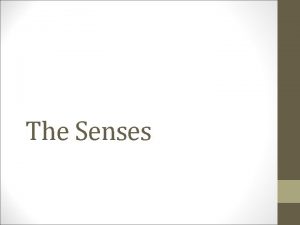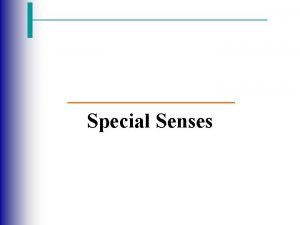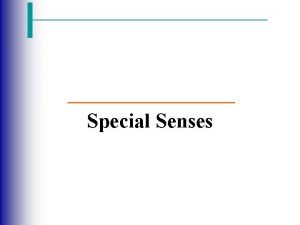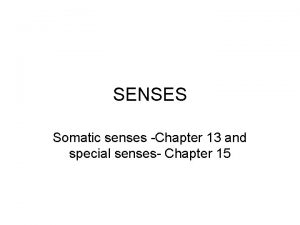SPECIAL SENSES SENSATION OF SMELL LECTURER IN CHARGE

















- Slides: 17

SPECIAL SENSES SENSATION OF SMELL LECTURER IN CHARGE: BAMIDELE O. 1

OLFACTORY NEUROEPITHELIUM • The sensory organ which are responsible for smell is described as olfactory neuroepithelium. • This is situated high up in the special bones of the nasal cavity called turbinates. • The olfactory epithelium is made up of olfactory cells that are bipolar sensory cells otherwise known as olfactory receptors, the supporting cells and mucus producing cells. • It is found above the main air stream. Hence smell is perceived on it by eddy current. 2

Turbinate bone 3

OLFACTORY NEUROEPITHELIUM CONT'D • The process of sniffing enhances the direction of air stream to the receptors. • Odorous substances dissolve in the mucus layer before they can reach the receptor perception. • There are many small glands of Bowman in the space among the olfactory cells that secrete mucus onto the surface of the olfactory neuroepithelium. • Each olfactory receptor is a neuron that has short and thick dendrites with expanded ends called olfactory rods. • Cilia project from the rods to the surface of the mucus. The cilia are minute unmyelinated neural processes. 4

CHARACTERISTICS OF AN ODORIFEROUS SUBSTANCE • The substance must be volatile so that it can be sniffed into the nostrils. • It must at least be slightly water soluble so that it can pass through the mucus to the olfactory cells. • It must also be lipid soluble. This is because olfactory cilia and outertips of the olfactory cells are composed principally of lipid materials. 5

THE OLFACTORY PATHWAY • The axons of the olfactory receptor neurons project upward by piercing the cribriform plate of the ethmoid bone and enter the olfactory bulbs. • There about 5 million receptor cells in each olfactory neuroepithelium in man all of which give rise to axons that travel in about 20 nerve bundles passing to the olfactory bulbs. • The axons of the receptor cells mix with dendrites of the mitral and tufted cells to form globular synapses known as olfactory glomeruli in the olfactory bulb. 6

Figure 1: The olfactory pathway 7

THE OLFACTORY PATHWAY CONT'D • Approximately 26, 000 axons terminate in each glomerulus that contains processes from about 34 mitral and 68 tufted cells. • From the olfactory bulb, nerve fibres pass through the intermediate and lateral olfactory striae which lead ultimately to the medial and lateral olfactory areas. • The medial olfactory area lies centrally above and in front of the hypothalamus. The two lateral areas lie in the temporal lobes. 8

PHYSIOLOGY OF SMELL • Odoriferous substances first dissolve in the moist lining of the olfactory membrane. • Then odoriferous substance react with the olfactory receptors to generate a receptor potentials. • The receptor potentials generated in these receptors promote the formation of action potentials. • The action potentials are transmitted in the olfactory pathway to the olfactory cortex. 9

ARE THERE PRIMARY SENSATIONS OF SMELL? • Attempt to identify primary smell sensations has not been successful. • Though, there was a classification that identified seven primary odours such as: 1. camphoraceous 2. floral 3. musky 4. peppermint 5. Ethereal 6. pungent 7. putrid 10

ARE THERE PRIMARY SENSATIONS OF SMELL? • Another studies suggested that 50 or more primary smell sensations exist owing to the fact that people have been identified to have odour blindness for single substances which are more than fifty. • It was believed that odour blindness for each substance signifies a lack of the situable receptor cell for that substance. 11

AFFECTIVE COMPONENTS OF SMELL • There also affective components of smell and they are: * Pleasant * Unpleasant • Smell can be pleasant when aromatic and fragrant substances are perceived but it can be unpleasant when perceiving stinking or foul smell from the environment. 12

THE ROLE OF SMELL SENSATIONS 1. It elicits GIT secretion in response to pleasant food such secretions are saliva and gastric juice. 2. It is protective i. e it warns against spoilt food by registering unpleasant smell. 3. It affects the selection of food. 4. It monitors the hygiene of your immediate environment. 5. It affects the emotional state of an individual. 6. It influences sexual behaviour in the form of attention and attraction. 7. It provides information connected with family or outsiders 13

ABNORMALITIES OF SMELL Anosmia: This is absence of the sense of smell. It may be temporary or permanent. Temporary anosmia is due to obstruction of nose, which occurs during : - Colds or allergies producing excessive mucus - Polyps causing blockage -1/3 are from zinc deficiency Permanent anosmia occurs due to lesion in: - olfactory tract, - meningitis and degenerative conditions such as Parkinson disease and Alzheimer disease 14

ABNORMALITIES OF SMELL • Hyposmia: This is the reduced ability to recognize and to detect any odor. - causes are the same with anosmia • Hyperosmia is the increased or exerggerated olfactory sensations. It is also known as olfactory hyperesthesia. It occurs in: - brain injury - epilepsy - neurotic conditions 15

REFRENCES • Oyebola D. O. (2002) Essential Physiology for students of Medicine, dentistry, Pharmacy and Related disciplines. Volume 2. • Sembulingam k. (2015) Essentials of Medical Physiology, 6 th Edition. 16

THAHK YOU FOR YOUR ATTENTION STAY SAFE 17
 Lecturer's name or lecturer name
Lecturer's name or lecturer name What is the difference between somatic and special senses
What is the difference between somatic and special senses General senses vs special senses
General senses vs special senses The chemical senses taste and smell review worksheet
The chemical senses taste and smell review worksheet Lecturer in charge
Lecturer in charge Lecturer in charge
Lecturer in charge Cn 3 nerve
Cn 3 nerve The general
The general Special senses quiz
Special senses quiz Cranucle
Cranucle What are the special senses
What are the special senses Chapter 15 special senses
Chapter 15 special senses Building vocabulary activity: the special senses
Building vocabulary activity: the special senses Chapter 17 special senses answer key
Chapter 17 special senses answer key Somatic and special senses
Somatic and special senses Extraocular muscles
Extraocular muscles The cones of the retina are coursera quiz answers
The cones of the retina are coursera quiz answers Chapter 15 special senses
Chapter 15 special senses








